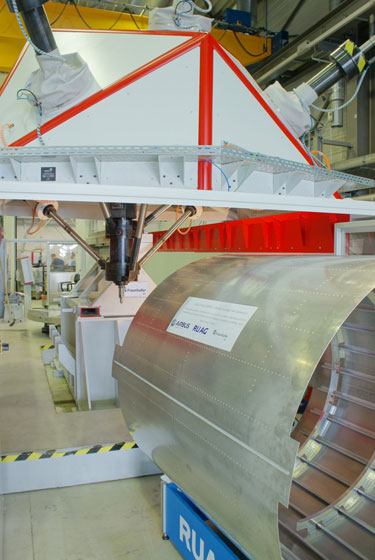Research on lightweight and efficient metal aircraft fuselages
For more than a decade, Fraunhofer IWS engineers and scientists have been researching joining technologies and industrial concepts to reduce the production costs and time of manufacturing lightweight aircraft fuselages. Friction stir welding processes for aerospace application have been under development at IWS since 2009. The technique appears to be especially suitable for welding the outer skin of aerospace structures since the high-strength aluminum alloys can maintain the excellent properties in the weld seams. This implies an enormous weight savings potential compared to the conventional riveting techniques for fuselage assembly.
However, many challenges have to be managed before the fast friction stir welding will play out its advantages in large component assembly lines for aircraft fuselages. IWS engineers are researching novel machine concepts, which would enable the joining of such large parts. For example, the outer skin of the aircraft cannot be deformed due to the higher forces during the welding process. Since 2009 IWS participates in the aerospace research program IV and works under an Airbus contract to further industrial concepts within the technology project MERGE (Next Generation Metal Fuselage). The Federal Ministry of Economics and Technology BMWi is funding this work to support the development of advanced civil aerospace technologies in Germany.
Current results show such concepts already working on the laboratory scale. Experimental fuselage components (scaled down1:4) were obtained from Airbus supplier RUAD in Oberpfaffenhofen. These parts have nearly realistic fuselage section geometries and were welded to form barrels. The welding system was a Pentapod machine from the midsized company METROM in Chemnitz. This machine was originally designed as a milling center. It was acquired by IWS with support from the EU and SMWK and then further developed into a full-featured friction stir welding machine.
Based on these very promising results it is now planned to transfer the process to real (scale 1:1) parts to further support the technology evaluation.
 Fraunhofer Institute for Material and Beam Technology IWS
Fraunhofer Institute for Material and Beam Technology IWS